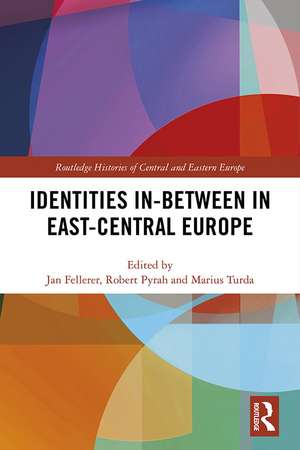Identities In-Between in East-Central Europe: Routledge Histories of Central and Eastern Europe
Editat de Jan Fellerer, Robert Pyrah, Marius Turdaen Limba Engleză Hardback – 22 aug 2019
| Toate formatele și edițiile | Preț | Express |
|---|---|---|
| Paperback (1) | 311.41 lei 6-8 săpt. | |
| Taylor & Francis – 31 mar 2021 | 311.41 lei 6-8 săpt. | |
| Hardback (1) | 1000.27 lei 6-8 săpt. | |
| Taylor & Francis – 22 aug 2019 | 1000.27 lei 6-8 săpt. |
Din seria Routledge Histories of Central and Eastern Europe
-
 Preț: 311.41 lei
Preț: 311.41 lei -
 Preț: 311.90 lei
Preț: 311.90 lei - 8%
 Preț: 382.96 lei
Preț: 382.96 lei -
 Preț: 310.55 lei
Preț: 310.55 lei - 9%
 Preț: 868.44 lei
Preț: 868.44 lei -
 Preț: 311.48 lei
Preț: 311.48 lei -
 Preț: 310.22 lei
Preț: 310.22 lei -
 Preț: 310.84 lei
Preț: 310.84 lei -
 Preț: 310.99 lei
Preț: 310.99 lei -
 Preț: 389.66 lei
Preț: 389.66 lei -
 Preț: 310.22 lei
Preț: 310.22 lei -
 Preț: 310.84 lei
Preț: 310.84 lei -
 Preț: 163.03 lei
Preț: 163.03 lei - 18%
 Preț: 1000.27 lei
Preț: 1000.27 lei -
 Preț: 309.79 lei
Preț: 309.79 lei - 18%
 Preț: 1000.27 lei
Preț: 1000.27 lei - 16%
 Preț: 264.98 lei
Preț: 264.98 lei - 18%
 Preț: 1006.77 lei
Preț: 1006.77 lei -
 Preț: 385.47 lei
Preț: 385.47 lei - 18%
 Preț: 1001.39 lei
Preț: 1001.39 lei - 18%
 Preț: 1000.27 lei
Preț: 1000.27 lei - 18%
 Preț: 887.43 lei
Preț: 887.43 lei -
 Preț: 387.49 lei
Preț: 387.49 lei - 18%
 Preț: 1001.90 lei
Preț: 1001.90 lei -
 Preț: 389.66 lei
Preț: 389.66 lei - 18%
 Preț: 1006.43 lei
Preț: 1006.43 lei - 18%
 Preț: 1109.18 lei
Preț: 1109.18 lei - 19%
 Preț: 269.84 lei
Preț: 269.84 lei -
 Preț: 311.41 lei
Preț: 311.41 lei - 18%
 Preț: 1003.30 lei
Preț: 1003.30 lei - 18%
 Preț: 1000.27 lei
Preț: 1000.27 lei - 18%
 Preț: 1006.77 lei
Preț: 1006.77 lei - 17%
 Preț: 259.72 lei
Preț: 259.72 lei -
 Preț: 391.02 lei
Preț: 391.02 lei
Preț: 1000.27 lei
Preț vechi: 1219.84 lei
-18% Nou
191.40€ • 199.84$ • 158.41£
Carte tipărită la comandă
Livrare economică 04-18 aprilie
Specificații
ISBN-10: 0367244659
Pagini: 306
Ilustrații: 6 Halftones, black and white
Dimensiuni: 156 x 234 x 19 mm
Greutate: 0.45 kg
Ediția:1
Editura: Taylor & Francis
Colecția Routledge
Seria Routledge Histories of Central and Eastern Europe
Locul publicării:Oxford, United Kingdom
Public țintă
PostgraduateCuprins
Introduction
by the Editors
Chapter 1: The Fallacy of National Studies
by Tomasz Kamusella
Chapter 2: Hybrid Identity into Ethnic Nationalism. Aromanians in Romania during the 19th Century and the Beginning of the 20th Century
by Steliu Lambru
Chapter 3: Minority Femininity at Intersections: Hungarian Women’s Movements in Interwar Transylvania
by Zsuzsa Bokor
Chapter 4: The Memory of a Hurt Identity: Bucharest’s Jewish Subculture between Fiction and Non-Fiction
by Oana Soare
Chapter 5: The Moldavian Csangos as Subculture: A Case Study in Ethnic, Linguistic, and Cultural Hybridity
by R. Chris Davis
Chapter 6: Nazi Divisions: A Romanian-German ‘Historians’ Dispute’ at the End of the Cold War
by James Koranyi
Chapter 7: Cosmopolitanism as Subculture in the former Polish-Lithuanian Commonwealth
by Simon Lewis
Chapter 8: Internationalist Working-Class Militant Biographies, Identity, and Sub-Culture in Late Russian Poland
by Wiktor Marzec
Chapter 9: The Past That Never Passes and the Future That Never Comes: ‘Palimpsestual’ Identity in Oleksandr Dovzhenko’s Diaries
by Olha Poliukhovych
Chapter 10: ‘Small’ Germans and ‘Half’-Germans in the Baltic Provinces at the Turn of the 20th Century
by Pauls Daija and Benedikts Kalnačs
Chapter 11: A War Experience in a Bilingual Border Region: The Case of the Memel Territory
by Vasilijus Safronovas
Chapter 12: (Mis)Matching Linguistic, Geographical and Ethnic Identities: The Case of the East Frisians
by Temmo Bosse
Chapter 13: Ethnic Identity in Other Nations’ Conflicts: Defining Frisianness in the 1920s
by Nils Langer
Index
Notă biografică
Robert Pyrah is Research Associate at the Faculty of Medieval and Modern Languages at Oxford University and Member of the History Faculty.
Marius Turda is Professor in Twentieth Century Central and Eastern European Biomedicine at Oxford Brookes University.
Descriere
This volume addresses the question of 'identity' in East-Central Europe. It engages with a specific definition of 'sub-cultures' over the period from ca. 1900 to the present and proposes novel ways in which the term can be used with the purpose of understanding identities that do not conform to the fixed, standard categories imposed from the top down, such as 'ethnic group', 'majority' or 'minority'. Instead, a 'sub-culture' is an identity that sits between these categories. It may blend languages, e.g. dialect forms, cultural practices, ethnic and social identifications, or religious affiliations as well as concepts of race and biology that, similarly, sit outside national projects.
